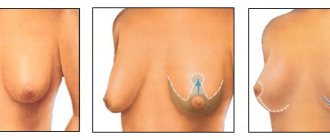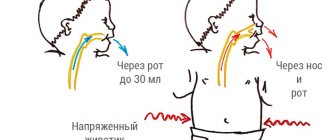All “newly made” parents face difficulties when their first child is born. Some people do not understand whether it is necessary to hold a newborn upright after feeding. Pediatricians have differing opinions on this issue. Some experts believe that all newborns should be placed in an upright position after each feeding. Others talk about an individual approach in this matter. Let's figure out why you should hold your baby upright after feeding, how to do it correctly, and whether your baby needs it.
Is it necessary to hold a newborn upright after feeding?
The functioning of the digestive tract of a newborn has serious differences in comparison with an adult body. The peculiarity of the intestines of newborns is such that it is prone to the appearance of spasms and intestinal colic. During feeding, the baby often swallows a small amount of air. This does not depend on the type of food - breast milk or formula. The baby swallows a lot of air and is constantly distracted and anxious during feeding.
There are newborns with a fairly strong digestive system. They don't have colic. However, there are few such kids. Basically, the accumulated air in the baby’s intestines causes very restless behavior: the baby pulls his legs towards his stomach, wriggles, and screams shrilly. Most often, such symptoms of colic occur in the evening and at night. To ease the baby's suffering, pediatricians advise holding him in a column.
Another problem that a newborn may experience is regurgitation. They can be with very plentiful amounts of food. This problem often occurs in children who are bottle-fed. Breast milk has a more optimal composition and causes fewer digestive problems. If there is excessive regurgitation, pediatricians recommend feeding the baby an antireflux formula. And in this case, in a vertical position (in a column), it is much easier for the baby to burp air with a certain amount of formula or milk.
Also, some newborns tend to overeat. This is most typical for children who are bottle-fed. Breast milk is almost always produced as much as the baby’s body requires. For a mother feeding formula, it is sometimes difficult to calculate an individual portion for the baby. Because the baby may have a wonderful appetite and eat all the formula from the bottle.
So, a newborn baby must be held upright after feeding in the following cases:
- profuse regurgitation
- tendency to overeat
- restless behavior during feeding, haste, greedy sucking
- symptoms of intestinal colic
If your baby does not have such problems, then it is not necessary to hold him in a column. Although this position is useful for strengthening the muscles of the neck and back. If at least one of the problems described applies to your baby, then he needs to be carried in a column after each feeding. Even at night, when you especially want to sleep. It’s not just the mother who can carry the baby in a column. This can be entrusted to the baby's dad, grandmother or grandfather.
Until what age should a baby be held upright after feeding?
There is no exact period until which it is necessary to keep children upright - everything is individual. On average, pediatricians recommend using this method until 4-6 months of age. By this period, the digestive tract is already ready to accept more adult food.
If regurgitation and colic stop earlier, you can therefore give up vertical holding earlier. To calm a child, the column pose can be used without age restrictions - the main thing is that it makes the baby and his parents happy and calm.
How to properly carry a newborn baby after feeding?
The muscles of a newborn baby are not developed at all. He has not yet mastered coordination skills. Of course, you need to carry it in a column very carefully. Use the recommendations below:
- Place a diaper on your shoulder so that if your baby regurgitates some food, your clothes will remain clean.
- Gently pick up the baby, holding the head and neck with one hand and the lower back with the other.
- Smoothly move the baby to a vertical position so that the chin is on mother’s shoulder. Remember not to pick up your newborn by the joints. You may damage them.
- Watch your baby's head to make sure it doesn't fall back. To do this, hold the back of the baby's head and neck with your hand. With your other hand, hold the baby's back at the bottom.
- A newborn's legs should be freely lowered, unless the baby bends them himself.
- Hold your baby firmly, but do not press too hard to avoid damaging the chest.
- Don't make sudden movements. This can scare the baby.
- Carry your baby in a column for no more than 10 minutes. Usually 5 minutes is enough. Prolonged vertical loads are contraindicated for newborns, since their body is not yet ready for it.
No matter how hard the mother tries, choosing special bottles or following a diet, the problem of gas formation in a newborn cannot be eliminated. This is how the baby’s body works. Due to the immaturity of the gastrointestinal tract, the child cannot voluntarily release the air obtained with food. He needs help with this. By holding the baby in a column, you help not only relieve pain in the baby’s tummy, but also strengthen his neck and back muscles.
Even if your baby does not have digestive problems and you do not carry him in a column, in any case, place the baby in the crib on his side (you can place a diaper cushion under the backrest). Newborns with good digestion (and even more so with problematic ones) in some cases can regurgitate leftover food. Swallowing them may cause suffocation. Take care of your baby!
Constant contact with the mother is very important in the first months of life for the baby. In addition, everything that is around is interesting to him; the baby needs to learn about the world around him, but he cannot move independently. Therefore, you need to carry it in your arms, but you should do it correctly. After all, a newborn’s musculoskeletal system is not formed and the spine can be damaged. There are many ways to carry on your hands, one of the most optimal is the “column”.
Different ways to carry newborns in your arms
There are several of them, and we will talk about each in detail.
“Lullaby”
A classic way of carrying babies, mothers master it on an intuitive level. So, how to properly carry a newborn in the “cradle” way:
- the child is in a horizontal position on his back;
- one hand holds the baby under the back, the head lies on the same hand, on the elbow;
- the other mother holds the baby's entire body.
In this position it is convenient to rock the baby, you can communicate with him - he can see the mother’s emotions and facial expressions, he can hear her voice well.
The main thing is to change hands from left to right so that the child does not develop scoliosis and torticollis.
Column
Mothers know how useful it is to hold a newborn upright after feeding - this is a good prevention of frequent regurgitation of milk, it will be easier for him to burp air. This position is also useful for preventing intestinal colic. It is important to hold the newborn correctly:
- You cannot carry a baby in this position for more than 10-15 minutes, since the vertical load on the spine is not beneficial for the newborn;
- the baby needs to be laid facing you so that his head lies on his mother’s shoulder;
- one hand holds the head and neck, the other – the butt and legs;
- It is better to place a folded, clean diaper under the baby’s head.
Photo source: shutterstock.com
On the stomach
This position helps well with intestinal colic - in this position, gases pass much more easily:
- With one hand, the mother takes the baby under the tummy;
- with the other hand, holds the entire body of the child, while the head rests on the elbow.
Children like to “fly” in the arms of an adult in this position.
Carrying children in front (or in Buddha pose)
Let’s make a reservation right away – this pose has nothing in common with Buddhism or yoga. So she is called for the contemplative appearance of the baby in this position:
- the baby is in an upright position, with its head and back resting on the mother’s stomach;
- the mother holds the baby under the breast with one hand;
- The other hand holds the flattened feet.
The main thing in this position is not to hold the baby for a long time in order to avoid unnecessary stress on the fragile spine.
Mom takes the little one in her arms, thereby telling him: “I’m here, I’m close, I love you, you’re safe.” In the first month, only the language of touch is available to the baby, and there is no better way to tell your baby about your love than to hold him in your arms.
We carry a newborn in a column
Until the child learns to move on his own, adults need to carry him. But this must be done carefully. Incorrect body position of a newborn will lead to serious problems:
- scoliosis;
- chest deformation;
- spinal injuries;
- incorrect formation of posture.
Correctly carrying a baby in your arms (holding) contributes to the formation of posture, balance, and the entire musculoskeletal system.
You need to carry a child in your arms often, especially during the first 6–7 months, until he learns to walk or crawl (see when children begin to crawl).
Important to remember! For a newborn, skin-to-skin contact with the mother is very important. Being held in his arms, he not only moves in space, but feels maternal care and affection. Thus, psychological and emotional contact is maintained. Children, even at an older age, need their mother's touch. Psychologists believe that a mother should touch her baby at least 100 times a day (pat him on the head, hold his hand, etc.).
There are many ways to carry a baby in your arms, the most optimal is “column”. In this position, the child is comfortable and the spine is not injured.
Why carry your baby upright?
- During feeding, air may get in with the milk, so the baby may spit up frequently. Immediately after feeding, it is taken in a column.
- If your baby is bothered by stomach cramps. In the column position, the tummy warms up and gases pass more easily.
- In this position, it is convenient for the baby to explore his surroundings.
- Proper wearing in a column has a positive effect on the development of the musculoskeletal system.
- You can support the child with one hand. The second will remain free for household chores.
With proper breastfeeding, the baby will not swallow excess air and the problem of constant regurgitation will become irrelevant. If you are feeding with artificial formulas, then there is the question of choosing the right baby bottle.
You not only need to hold the baby correctly, but you also need to talk to him while carrying him in your arms. At the same time, you need to do simple household chores, the child must get used to the fact that mom needs to do something. By doing this kind of work and carrying the baby in your arms, you can free up additional time for more complex tasks.
How and how long to hold a newborn upright
Somewhere between 20 and 25 days after birth, the baby begins to sleep much less and demands to be handled. He is interested in looking at everything, and it is most convenient to do this when he is carried in his arms.
Naturally, holding a child in your arms all the time is also not advisable. For some time he should lie alone, under unnoticed supervision, the baby should get used to playing independently.
Please note: If you often take children in your arms, then in the future this will become their whim and, as a result, a problem for the parents. If you have already encountered such a problem, then read how to wean your child off your hands.
The baby is carried in a column when he:
- ate;
- wants to look around;
- he is bothered by stomach cramps.
The right support
Initially, the baby is held with both hands. Later, when mother and child get used to this position, it will be possible to support with one hand, following certain rules:
- The child must be supported by the body in the chest area.
- Make sure that the baby's arms and legs do not hang outstretched. The child must be grouped.
- There is no need to support the baby's head; he has been holding it on his own since birth.
- You cannot support your head and body with different hands. As a result of unsynchronized movement, the cervical vertebrae can be damaged.
- The child should be carried with his stomach facing him. This pose helps improve digestion and maintains psycho-emotional contact.
The child is carried in a column depending on his needs. If you take the baby in your arms so that he burps after eating, then you do not need to hold him in this position for a long time (before picking up the baby in your arms in this case, do not forget to put an oilcloth on your shoulder). You should not carry your baby for more than 10 minutes, even if he has not burped. It's better to put him on his back and talk to him or play.
If the stomach bothers him, or the baby needs to “travel,” then he will have to wear it for a long time. As much as he needs until his stomach stops hurting or until he gets some weight.
It is important to know! In order not to harm the baby when carrying him in a column, you need to support the head and torso with one hand. It should run diagonally along the child's back. The other hand supports the newborn's legs until the mother learns to hold him with one hand. When holding the baby, you should pay attention so that he does not sit on the other hand.
When the first child appears in the family, it is time for parents to acquire new knowledge and skills. The baby requires special care, especially in the first months of his life. Indeed, during this period, the baby’s body adapts to new conditions of existence and is not yet able to fully cope with its functions. One of the foundations for the proper growth and development of a baby is the organization of the nutritional process. After finishing feeding, in some cases it is necessary to hold the newborn in an upright position. What is it for? How to properly hold a baby upright? In what cases should this be done? The answers will be given in the article below.
Why pick up a baby?
In the days of our mothers and grandmothers, it was believed that the less a child is in the arms of his parents, the less he is capricious and cries. If a child is constantly held in his arms, this is a sign of poor upbringing and pampering.
But psychologists have proven that an infant needs to be held in his arms so that he grows up healthy and calm. And holding a newborn baby in your arms is simply necessary for its correct and harmonious development.
The baby spent nine months in his mother’s belly, heard her voice, felt her heartbeat. After birth, everything around him is new and unusual; he simply needs to feel his mother’s warmth as often as possible. Lack of tactile contact with mom can cause restless sleep and tearfulness.
At an older age, such a child may develop various neuroses, enuresis, problems with peers (such children are often pugnacious and conflict-ridden), and this is not a complete list of problems.
If you hold a newborn in your arms, then:
- baby cries less;
- the child’s body temperature, blood pressure and blood sugar levels are normalized;
- the level of stress hormone in the baby’s blood decreases;
- the child develops harmoniously physically, psychologically and emotionally;
- “tame” children explore their surroundings more actively and willingly;
- The baby establishes close contact with his mother, which is very important for his normal development.
Numerous studies have shown that children who are held a little in their arms in infancy grow up to be more insecure, adapt less well to new conditions and are more likely to have problems with speech development.
Photo source: shutterstock.com
Why hold a baby upright?
Young parents are primarily concerned with the question of “how to hold a child upright.” The answer to this will be provided a little later. After all, you first need to understand why such a procedure is needed at all. There are several reasons why you should keep your baby upright:
- To improve digestion. Sometimes it happens that when feeding, the child swallows air along with food. This can subsequently cause abdominal pain and discomfort. If you pick up the baby after feeding and hold it in a column for a while, this will help the air that was previously swallowed to escape.
- For motion sickness. Many babies, when their parents hold them in an upright position, cuddling them, calm down and even fall asleep. After all, in this position, children feel the warmth of an adult’s body and experience a feeling of comfort.
Do not forget that before carrying out various manipulations with the baby, you must understand how to properly hold the child in a column.
What to do if your baby falls asleep
During feeding (especially when breastfeeding), children often fall asleep. In this case, it is not recommended to wake the child, because he has eaten the amount of food he needs and is not bothered by pain.
Therefore, children who have fallen asleep should be carefully placed in the crib on their side and a support placed under their back in the form of a bolster from a blanket or a small pillow. If during sleep the child begins to regurgitate food, you can gently pick him up while sleeping and hold him for a while.
When should you not hold your baby in an upright position?
In modern society, there is an opinion that differs from the recommendations of Soviet pediatrics. It’s not just human children who are born with an immature digestive system. The babies of many animals are born with the same problem, but their mothers do not hold the newborns in a column. Therefore, in the case when the child is completely breastfed and is trained to take the breast correctly, the question of swallowing air arises extremely rarely. In addition, with this diet, overfeeding does not occur.
Should I hold my baby upright after feeding if he is breastfed? If the baby does not show signs of anxiety, does not cry and falls asleep during or after eating, then the answer is negative.
What to do when spitting up
It is recommended to keep it in a column after feeding if the baby spits up frequently and a lot. This leads to the fact that he absorbs less food than he ate. In addition, during regurgitation in a horizontal position, the newborn may choke.
If your baby spits up frequently and a lot after eating, you should definitely consult your pediatrician. If necessary, the doctor will prescribe examinations that will help rule out serious diseases. In most cases, there is nothing wrong with spitting up. Until 7-8 months, this process is physiological, and with age such episodes occur less and less often.
If the baby is prone to regurgitation, but falls asleep during feeding, you need to turn him on his side. In this position, milk will not enter the respiratory tract. When the baby has already eaten, but is not yet sleeping, you need to hold him in a column, and after the air has passed, put him to sleep.
When should you hold your baby upright?
Parents should hold their baby upright for a while in the following cases:
- The child behaves restlessly while eating. One of the reasons for this behavior may be that the baby has already swallowed air, and now it gives him unpleasant sensations.
- The baby is very hungry and eats quickly and greedily. If a child has spent more time without food than usual, it means that when feeding, he most likely swallows air due to his haste.
How to hold a child upright and how to pick him up correctly before doing this? The answers to these questions are given below.
In what cases does the method not work?
When a child eats greedily during feeding, gets distracted, and then starts eating again, he will definitely swallow air. It is necessary to hold him in a column until he burps, otherwise the mother will have a restless night.
If the feeding was quiet, the baby ate well and immediately fell asleep, you don’t have to get him up. After eating, a sleeping baby is turned on its side, stroking its back. The baby can also burp on its side. If this does not happen, you can wear it after waking up.
It is better to feed especially sensitive babies who wake up and begin to stay awake even after heavy feeding at night in a semi-vertical position. Then the child will be able to burp in his mother’s arms and fall asleep. Some parents are faced with the fact that the baby does not like something, he is capricious while being held in a column, and the whole procedure turns out to be ineffective.
The problem can occur for several reasons:
- the smell coming from the mother (strong or too sweet perfume, deodorant);
- the fabric of an adult’s clothing (perhaps it is too rough and unpleasant to the touch). For contact with a newborn, it is better to use clothes made from natural rather than synthetic fabrics;
- the child may be disturbed by a foreign object (large button, brooch, pendant);
- mom's emotional state. In the first months, the bond between the newborn and the mother is very strong. If a woman is nervous or very upset about something, the baby will also feel it and will behave as restlessly as the mother.
How to properly hold a baby upright?
For hygiene purposes, it is first recommended to place a clean diaper on the adult’s shoulder. After the newborn is in the arms of one of the parents, you can give his body a vertical position. To do this, lift the baby so that his head is on the adult’s shoulder. One hand should support the head and neck, the other – the back and lower back. You cannot take a child under the buttocks, because this will create an unnecessary additional vertical load on the spine.
Another option for holding a child in a column is the following. You need to move the baby a little higher so that the baby’s chest is on the adult’s shoulder, and his head and arms are behind him. In this case, be sure to press the baby’s back and neck towards you.
How to properly hold a newborn in your arms
The first and most important rule is – don’t be afraid! You are a mother, and you have an intuitive sense of how to properly hold a newborn baby in your arms. There are several general rules:
- when placing the baby in a crib or stroller, you should hold it by the head and butt;
- one hand holds the baby by the back, the other holds the head and neck;
- before putting a baby down, hold him close to you and bend over like that, never place the baby on outstretched arms;
- Having laid the child on the surface, do not immediately remove your hands, let a few seconds pass so that the baby has time to adapt to the new sensations;
- You need to lift the baby when he is lying on his tummy as follows: with one hand, take him under the chest, holding him with the thumb and forefinger in the neck area, and with the other hand take him under the tummy, moving it between the baby’s legs;
- in the first two to three months it is better to swaddle the baby - this will be more comfortable for both the baby and the mother; During the waking period, it is better to swaddle up to the waist so that the arms are open, and to sleep completely.
And remember: when you take your little one in your arms, you charge him with your mood, try to avoid negative emotions. Some techniques are given to mothers intuitively, some are better learned - for example, how to hold a newborn after feeding.
What should not be done when holding a child in an upright position?
There are a number of prohibitions and warnings that you should pay attention to when giving the baby a vertical position:
- To avoid dislocation of the radius, do not lift your baby by holding his arms, hands, or forearms.
- To avoid throwing the head back and straining the neck muscles, do not lift the child by holding him under the armpits.
- There should be no abruptness in the parent’s movements, as this can frighten the baby.
- You need to hold the baby tightly to your body, but not too hard, so as not to cause pain.
How long to hold a child upright?
Each child is individual. Therefore, the baby can get rid of excess air within two to ten minutes. There is no clear and precise answer to the question “how long to hold a baby in an upright posture after feeding”? If after the specified time the baby is still worried, you should change his position and stroke his back.
There are pediatricians who advise keeping the baby upright after each feeding. But after a fairly short time, every mother can already understand whether her baby needs help in a particular situation.
In some children, the digestive system matures and ceases to bother them as soon as the baby learns to roll over onto his stomach. For others, until they learn to sit. Parents will be able to understand from the child’s behavior that he no longer needs help.
Why is this procedure necessary?
It is believed that it is necessary to hold the baby upright after feeding. This is historically associated with Soviet times, when mothers' maternity leave was 3 months, and they were forced to send their babies to a nursery. There, newborns were fed by the clock and in equal portions. No one paid attention to the individual characteristics of the baby’s body. Therefore, overfeeding, which manifested itself in regurgitation, was a common problem. To avoid this problem and the complications associated with it, the staff had to hold the baby upright after feeding.
How to hold a newborn upright is explained in maternity hospitals. But they don’t always tell you why it’s needed.
There are many reasons why this procedure is necessary. These include:
- improved digestion. When a baby feeds from a bottle, for example, it swallows air. This leads to discomfort in the baby's stomach. It turns out that first the mixture enters the stomach, and then air and then the mixture again. As a result, the air displaces the milk - the process of regurgitation occurs. This also applies to overfeeding the baby and improper breastfeeding. That is, when the baby's halos are grasped incorrectly. Therefore, doctors advise be sure to hold the baby upright after eating,
- for quick motion sickness. Some babies feel better when mom or dad cuddles him in an upright position. In this position he feels comfortable and feels parental warmth. This way the baby calms down and falls asleep faster. Often the process of falling asleep occurs when the mother holds the column after feeding,
- if held in a column after feeding a newborn, it helps strengthen the back muscles. In addition, the baby learns to hold his head on his own,
- observation skills develop. If you carry your newborn upright, he will be able to observe the world around him. Which will definitely cause a lot of delight in the little one.
What to do if your baby is worried in your arms
Despite the calming effect of the column pose, the child behaves restlessly in certain cases.
The reason for this may be:
- The fabric from which the clothing is made. Hard material and synthetics can cause discomfort and irritation when touching a child’s delicate skin. Therefore, when spending time with children, especially in direct contact with them, it is recommended to wear clothes made from natural fabrics.
- Smell. Perfumes, creams, deodorants and other cosmetics with a strong odor may be poorly tolerated by a child. Even a light fragrance in a cream can cause discomfort in children. Therefore, when contacting, it is better not to use cosmetics with odors. If there is a need to use them, you should give preference to natural, odorless products.
- Foreign objects. Nothing should disturb the child while holding him in a column, so it is recommended to remove earrings, brooch pendants, hairpins and other items. Also, jewelry always attracts the attention of children, they try to get it, and this can lead to accidental injury.
- Psycho-emotional state of a woman. A child can read and copy from birth. Therefore, before holding children in your arms, you should calm down, discard negative thoughts and tune in to the positive. This time should be given to the child, turning the activity not into routine and everyday routine, but into pleasure.
Holding your baby upright after feeding helps normalize digestion and prevent colic. This pose also allows you to calm children and develop the spinal muscles. The main thing is to do it correctly and follow all the recommendations of your treating pediatrician.
When you shouldn't carry your baby upright
Holding a baby upright is not recommended when breastfeeding. If the feeding process is established between mother and child and the baby latches onto the breast correctly, then the risk of swallowing air is reduced to a minimum and practically does not occur. Therefore, a newborn should not be carried in a column after feeding with breast milk.
When does it become necessary to carry your baby in a column?
There are cases when, even with natural feeding, you have to hold the baby vertically. You need to keep it in a column after feeding in the following cases:
- If the infant behaves restlessly during feeding.
- If there is a long period between feedings, the baby greedily and quickly swallows the milk.
- The angle of the bottle during artificial feeding is not maintained or the bottle itself is incorrectly selected.
When bottle feeding, it is best to hold your baby at a 45 degree angle. This reduces the risk of large amounts of air being trapped and reduces the likelihood of unwanted burping.
When the column pose is not needed
Diagram of a child's teeth
It is not always necessary to keep the baby in a column position. When a baby is breastfed and is latching correctly, there is very little chance that he will swallow air. If the baby behaves calmly after breastfeeding, then you should not keep him in an upright position.
Babies who feed only on mother's milk do not need this technique. They eat small meals and overeating is unlikely. If the baby was born on time, everything is in order with his health, he eats well and begins to sleep immediately after eating, there is no need to hold him upright.
Rules for carrying a baby vertically
Many people are interested in the question:
- How to hold a baby correctly? The main and main rule is the accuracy and smoothness of parental movements. At this moment, you need to address the child gently and with a smile, and try not to raise your voice. You can first pet the baby, talk to him, and only then carefully pick him up.
- How to carry a baby? Before picking up your baby, you need to wash your hands thoroughly. It is advisable to place a clean diaper or cloth on your shoulder. Only after these procedures can you pick up the baby. As soon as he is in an upright position, you need to make sure that the baby's head is on the diaper. To do this, carefully and carefully lift the child so that the head is on the parent’s shoulder. An adult supports the baby’s neck and head with one hand, and the back with the other. Children under six months old are not allowed under diapers. This avoids curvature of the spine due to weak spinal muscles. Another option for wearing in an upright position is to position the baby just above the parent's shoulder.
- How long should you keep your baby upright? Only the mother decides how long to wear it in an upright position. Most often, the baby remains in this position until all the air comes out or the baby calms down. Typically this time does not exceed five minutes. Older children love to be in an upright position. This makes it easier for them to look at objects, people, and animals.
Sometimes it happens that a nursing mother simply needs to carry her baby vertically. This helps in case of insufficient lactation to cause a flow of milk. Since during this period the connection between the child and the mother is very strong and a feeling of comfort and warmth is necessary for both. The joy hormone is released, which promotes the release of breast milk. In addition, both feel comfortable and cozy.
How to be dads
Dads - strong and brave - are often lost at the sight of a small creature. There are cases of fear before holding a daughter or son in her arms. Therefore, mom needs to try to tell dad in a simple and accessible way how to properly pick up the baby in an upright position:
- You should not lift a newborn by the arms,
- do not lift by the armpits,
- movements are smooth,
- Dad tries to firmly but carefully “fix” the baby in his arms. Do not press too tightly to yourself, you can interfere with blood circulation, which will cause discomfort and crying for the baby,
- don't let your guard down. Especially at night, when lack of sleep and general fatigue make themselves felt.
Having learned to handle the child carefully, dad will be able to replace a tired mother from time to time. And thus give the tired mother the necessary rest.
Is it necessary to hold the baby upright, and does this process depend on the amount of milk the baby has eaten? If the baby does not burp, then he does not need to be held upright, says Dr. Komarovsky. This position is needed for those children who are not gaining weight well, are bottle-fed, or are not latching onto the breast correctly. In other cases, such a pose is not necessary.
Only parents decide whether to hold their child in a column or not. It all depends on the circumstances and characteristics of the baby. This is exactly what you need to rely on when making this or that decision. Because no one except parents will say what is best for their child.











